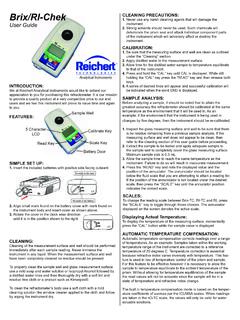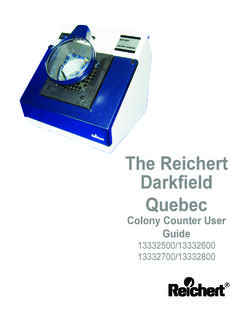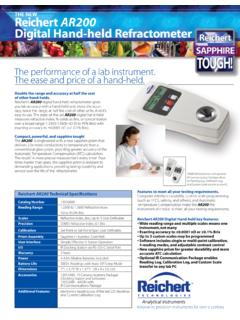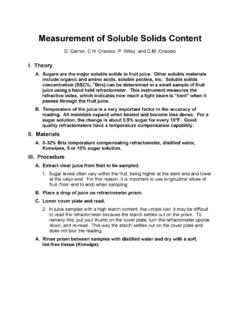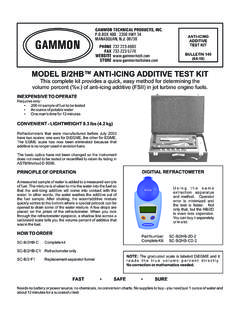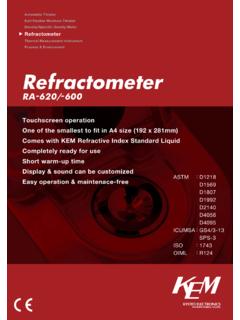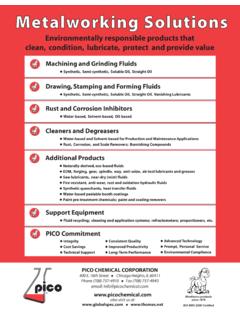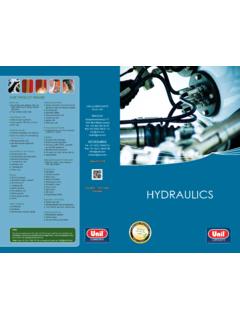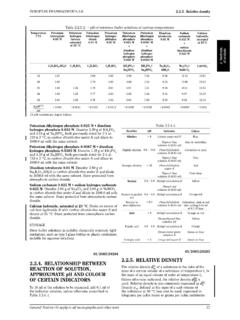Transcription of Why Use A Refractometer? - reichertai.com
1 Why Use ARefractometer?Everything You Wanted To Know About Engine Coolant TestingMichael ReimerWhy Use A Refractometer? Everything You Wanted To Know About Engine Engine Coolant/ ..1 Antifreeze Hydrometer Versus Hydrometers And Refractometers: The Ins And Outs .. Actual Test Date: The Real Deal .. The Problem With Inaccuracy: The Death Of A Beloved Family Member: Your Anatomy Of A Pitted Engine Coolant/Antifreeze Hydrometer Versus Duo-ChekCompetition is fierce in the automotive services field. Service facilities face an ever increasingfield of competitors, while consumers demand more and more from their service suppliers must provide equipment that will perform exceptionally, at a the battle for engine coolant/antifreeze concentration and freeze point protection leveltesters, the hydrometer accounts for roughly 75% of all units sold.
2 Refractometers and teststrips round out the field. When service personnel are asked if they feel that their enginecoolant tester is performing adequately, over 95% feel satisfied. Amazingly, 35% feel extremelysatisfied! The significance of this is that three quarters of these service providers feel that theirengine coolant tester must be accurate to 5 F. Less than one-tenth of those surveyed felt thatan inaccuracy of 10 F or worse was curious fact about this is that even a high precision, laboratory hydrometer (which costsover $ ) used by a trained laboratory technician in a controlled environment, using readingswhich have been mathematically corrected for fluid temperature can t obtain that to ASTM Method D1124, the best accuracy that is achievable with a hydrometerused under these specific conditions is 8 F.
3 So, how can we reconcile this fact with theoverwhelming feeling of satisfaction that service personnel have regarding their , they do not realize just how inaccurate hydrometers really are! Hydrometers and Refractometers: The Ins and Outs Hydrometers measure specific gravity. Specific Gravity is extremely temperaturedependent. The same sample which is read at 150 F will read as having a 30 F better freezepoint protection level if it is read at a temperature of 100 F. Temperature effects must becalculated. Hydrometers only work for Ethylene Glycol based coolant/antifreeze. Propylene Glycolcannot be read with a hydrometer due to the fact that up to 70% concentration specificgravity increases, but above 70% specific gravity decreases. A 100% solution reads identicalto a 40%. Sampling technique is critical in hydrometer use.
4 Air bubbles in the sample will causeinaccurate readings. The float must be kept free from the wall of the hydrometer. Refractometers can measure both Ethylene and Propylene glycol based coolant/antifreezevery Automatic Temperature Compensation is an absolute necessity for refractometers. Withoutit, refractometers can easily be inaccurate by more than 16 F. With ATC, the Duo-Chek isaccurate to 1 F straight out of the box, according to ASTM Method D are numerous reasons why it is very difficult to obtain an accurate engine coolantconcentration reading with a hydrometer, but first let us try to understand why they are sopopular. Probably the most important reason for the wide spread us of these instruments is thatthey are very inexpensive. A hydrometer is simply a container with a weighted float device. Anapplicable scale is displayed either on the cylinder of the container, or on the float whichcorrelates the specific gravity (which is measured by how much of the float remains above thefluid level) and the particular concentration of interest.
5 There are several different styles ofhydrometer, but they all work off this same are also popular among service mechanics because they are a visual indicator offluid quality. When a car pulls into a service shop to have a lube job and oil change, the serviceshop wants to perform as many extra services as possible. Not only does it ensure the propermaintenance of the vehicle, but most of the income for these shops comes from sellingcustomers on these extras, not on the initial service. Typically, they will check the air filter, testtransmission fluid, engine coolant, and maybe even brake fluid. For the engine coolant, thetechnician can take a sample with the hydrometer, and show this to his customer. This givesthe customer the feeling that he is informed enough to make a qualified decision of whether ornot to purchase the extra service of flushing out his coolant system.
6 An informed customer isa happy that we know why someone would want to use a hydrometer, let s turn our attention towhy someone would not want to rely on one. For starters, hydrometers are actually far moredifficult to use accurately than they appear. When you purchase a hydrometer, the instructionsare very basic. Take a sample and read how many discs or balls are floating or how high a floatsits in the sample, etc. Then take this number of floating discs or balls, or height of the float andrefer to a chart that converts this number into the useful measure of concentration and freezepoint protection. That s it! In reality, there is a lot more to it than that. Here is what they do nottell you:Remember that a hydrometer is actually measuring the specific gravity of a solution. How itaccomplishes this is to take a substance with a known specific gravity (a standard) and see ifit floats in the unknown sample.
7 If it floats, the specific gravity of the sample is greater than thespecific gravity of the standard. Disc and ball type hydrometers have discs (and balls) of increasing specific gravity. The morediscs or balls that float, the higher the specific gravity of the unknown. A single floathydrometer has a float which has a weighted bottom and a hollow top. This will sink into the3solution until the specific gravity of the unknown sample and the float are equivalent. Theamount of the float which is submerged is an indicator of the specific the most important factor in the use of a hydrometer is the temperature relationshipbetween the sample, the instrument, and the standard reference temperature. In order to obtainan accurate specific gravity reading it is imperative that the sample, and the instrumenttemperatures be at an equilibrium.
8 Readings must be taken at a specific, stable temperature must be noted for each reading. If this temperature differs from the standardreference temperature (which is typically 60 F, C for most hydrometers) the specificgravity reading must be mathematically converted to its equivalent value at the standardreference most substances, as temperature increases, specific gravity decreases. In other words thesample thins out as it is heated. This shift can be mathematically modeled. Refer to the chart Specific Gravities of Aqueous Ethylene Glycol Solutions at the end of this document for thistemperature dependence when measuring Ethylene Glycol via specific gravity. To familiarizeyourself with this type of chart, follow along with this example: A reading for a 50% ethyleneglycol solution at 100 F would give a specific gravity of This same 50% solution at 150 Fwould read as specific gravity.
9 If that hydrometer were calibrated for 100 F, it would readas 50% only if the reading was taken at a fluid/instrument temperature of 100 F. If the readingwas taken at a fluid/instrument temperature of 150 F, the instrument would measure thespecific gravity as which at the instruments standard reference temperature of 100 Fcorresponds to 35%. The person taking the reading would think that the solution was 35%Ethylene Glycol. As a reference, the freeze point protection level for a 50% mixture isapproximately -32 F. The freeze point protection level for a 35% mixture is approximately -2 is a very significant error!The chart Specific Gravities of Aqueous Propylene Glycol Solutions at the end of thisdocument reveals why a hydrometer cannot be used for measuring this environmentallyfriendly type of engine coolant/antifreeze.
10 As concentration increases to around 70%, specificgravity also increases. Above 70% however, specific gravity actually decreases with increasingconcentration. For instance, at 100 F, a 100% Propylene Glycol Solution has the same specificgravity as a 45% solution! There is no way for a hydrometer to differentiate these twodramatically different technique is also critical in specific gravity measurement. Any air bubbles present inthe sample can attach themselves to the float device and thus affect readings. For both typesof hydrometer, the specific gravity of the float will be reduced if an air bubble attaches itself tothe float (in other words, the buoyancy of the float will increase). An interesting test of thisphenomenon is to use a hydrometer to determine the sugar concentration of a soft drink. Takea reading by simply drawing the soft drink into the hydrometer.
